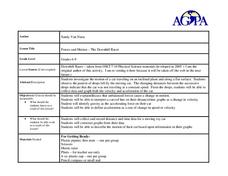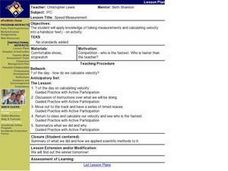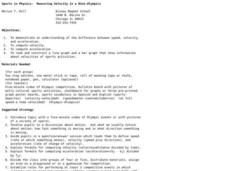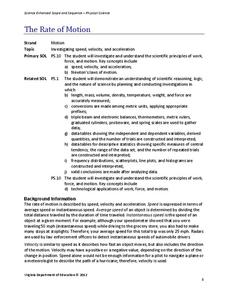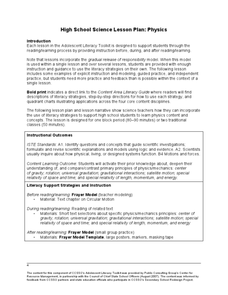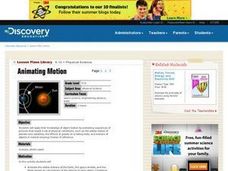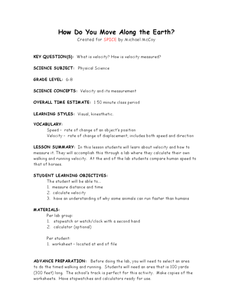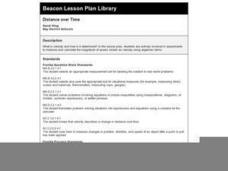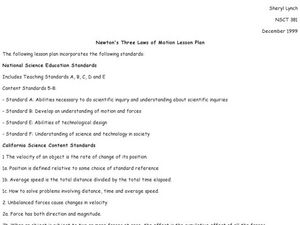Teach Engineering
Microfluidic Devices and Flow Rate
When you have to flow, you have to flow. The lesson introduces class members to microfluidic devices and their uses in medicine. They watch a short video on how the diameter affects the rate of flow. The worksheet has individuals...
Curated OER
Forces and Motion-The Downhill Racer
Learners calculate a toy car's velocity and acceleration. In this force and motion lesson, students build ramps and attach a dropper to a toy car, which is released down the ramp. Learners calculate and graph velocity and acceleration...
Curated OER
Speed Measurement
Learners are asked how do they calculate velocity? They take a trip to the school's track and have a series of timed races. Students return to class and calculate their velocity and see who is the fastest. They summarize what they did...
Curated OER
Sports in Physics: Measuring Velocity in a Mini-Olympics
Eighth graders examine the difference between speed, velocity and acceleration. In this velocity lesson students read and construct a line graph and a bar graph to show information about velocities of sports activities.
Curated OER
Tracking Speed
Students collect data for a runner by measuring the time it takes for the runner to run equal distances. After collecting data, students average speeds and accelerations for the runner. Assignment is completed by graphing the data.
Virginia Department of Education
The Rate of Motion
How much time does it take to jump over three balloons? Pupils calculate the speed of tasks that require different motions. They determine motions for tasks such as walking, skipping, hopping, and jumping before creating a spreadsheet...
Curated OER
Lesson 3: Acceleration and Force
A nine-page physics resource supports your lesson on acceleration. A step-by-step lesson plan walks you through the materials you need, the background information, steps for leading experimentation, and the explanation of the results....
Curated OER
Typical Numeric Questions for Physics I - Work and Energy
A total of 29 word problems furnish practice in solving for work, energy, and force. A few of the questions display diagrams to help learners visualize the systems, and all of them list five choices from which they select the correct...
College Board
2004 AP® Calculus BC Free-Response Questions Form B
Take another look at the exam. A set of questions is a different form for the 2004 AP® Calculus BC free-response question section. The questions are evenly split into calculator and non-calculator sections. Pupils use their knowledge of...
Corbett Maths
Average Rate of Change
Simply find the slope to find the average rate of change. A short video provides the definition of the average rate of change. Using the definition, pupils calculate the average rate of change to solve problems that cover finding average...
Curated OER
Circular Motion
Twelfth graders discuss centrifugal force, frictional force, and critical speed as it relates to the popular amusement park ride, the Gravitron.
Curated OER
Animating Motion
Students apply what they recall about objects in motion by animati ng sequences of pictures that model a set of physical conditions. They animate the orbital motions of the Earth, the space shuttle, and the Moon based on calculations of...
101 Questions
Pokémon Go Cheat
Gotta catch them all—no learner left behind! Young scholars must predict the length of time it takes a phone attached to a fan to travel five kilometers given the radius and rotations versus time data. Why would you attach a phone to a...
Curated OER
Impulsive Force Model
In this impulsive force worksheet, students calculate speed, force, and velocity for several word problems as it relates to the concepts in physics. Students also apply the momentum conservation equation to each problem.
Curated OER
Flying With Mathematics!
Third graders fly miniature airplanes to discover characteristics related to velocity and average speed. After measuring the time and distance of their flights, 3rd graders calculate the average velocity of their planes.
Curated OER
Physics Rewind
Eighth graders differentiate speed and velocity. In this physics lesson, 8th graders explain Newton's laws of motion. They calculate speed using a mathematical formula.
Curated OER
How Do You Move Along the Earth?
Students determine their own walking and running velocity. In this physics instructional activity, students calculate velocity using distance and time information. They compare human and animal speeds.
Curated OER
Distance over Time
Students analyze velocity and how it is determined. They experiment with velocity in order to measure and calculate the magnitude of speed. They use examples in their novel "Skateboard Renegade" to relate velocity to real life situations.
Curated OER
Motion
In this motion worksheet, students will read 8 statements about displacement and velocity and determine if the statement is true or false. Then students will fill in the blank for 8 statements on motion. Finally, students will compare...
Curated OER
Marble Madness
Middle schoolers determine the velocity of a marble rolling down the incline. In this physics lesson plan, students identify the independent and dependent variables in the experiment. They construct and analyze a graph.
Curated OER
Measuring Acceleration
Students create an accelerometer and take measurements of acceleration in a moving car. They study the car speeding up in a straight line, slowing in a straight line and curving at constant speed. They prepare a lab report showing...
Curated OER
Particle Models in Two Dimensions
In this motion worksheet, learners draw and label the trajectory of objects including the x-component and y-component of the velocity. Students calculate acceleration and speed. This worksheet has 7 problems to solve.
Curated OER
Newton's Three Laws of Motion Lesson Plan
Students explore Newton's three laws of motion using a variety of activities. In this physics lesson, students calculate the average speed of a vehicle they constructed using distance and time information. They identify and draw the...
Curated OER
Playground Games
Students compete in playground games in order to review velocity and wave behavior in real life situations. They demonstrate understanding by calculating velocity in their "Playground Games" packet.



